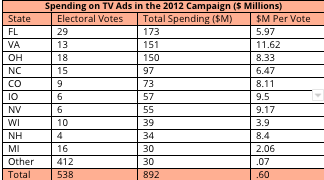How States Can Attract More Equal Political and Economic Investments during Presidential Campaigns
Battleground states make millions of dollars during each presidential campaign, while states whose voters lean hard toward one party or the other earn virtually nothing. In 2012, over 96.6% of $892 million spent on TV ads alone went to the 10 battleground states in that election. In 2016, Trump and Clinton spent almost 2.4 billion dollars on the race; again, almost all of the money ended up in battleground states. And the benefits to battleground states do not end on Election Day. Incumbent presidents target federal dollars to battleground states and pressure government agencies to shorten processing time for awards directed to them. Protectionist trade policies might even be tailored to benefit battleground states.
Advocates and policymakers have called for reforms to give more states leverage in presidential elections, and thus more evenly distribute electorally related benefits. However, many such reforms like abolishing the Electoral College in favor of direct elections are not viable because they advantage one party. A feasible alternative must not advantage either party. For that reason, reformers should look to the Competitive Plan.

Possible Approaches
Almost all states use the winner-take-all method of allocating their Electoral College votes. In this system, the candidate who receives the majority (technically the plurality) of the popular votes takes all of the electoral-college votes for that state. The candidate who receives the majority of 270 electoral votes then wins. Two alternatives in particular have been advocated by reformers:
-
In the Direct Election Plan, the president is elected based on the popular vote alone. However, many red states oppose the direct election of the president because it would benefit Democrats: If the winner of the popular vote had been elected president, a Democrat would have been elected in 2000 and 2016. To be viable, a new system must be unbiased. In addition, the new system must meet other criteria that many legislators consider important, such as supporting a two-party system and requiring a wider distribution of popular support to be elected president.
-
Another proposed reform is often called the Proportional Plan. It suggests that states assign their electoral votes in proportion to the statewide popular vote. For example, take a state with four electors. Under the standard interpretation of the proportional plan, if the Republican candidate receives 62% of the votes and the Democratic candidate receives 38%, the state would allocate two votes to both candidates. We propose a variation on the proportional plan, which we call the Competitive Plan. Under it, the state would allocate three votes to the Republican candidate and one to the Democratic candidate.
The Competitive Plan — Advantages and Obstacles
The Competitive Plan would benefit safe states by increasing revenue from elections and campaigns and making them politically relevant, incentivizing candidates to cater more evenly to state interests. An analysis of all of the presidential elections since 1900 demonstrates that the Competitive Plan does not offer either party a partisan advantage. Unlike all other suggestions for election reform thus far, the results of all 30 elections would have been identical if the Competitive Plan had been used to tally the votes.
However, there are obstacles to implementing the Competitive Plan. It could be enacted through a constitutional amendment, but this is an involved and unlikely process. It could be implemented state by state. However, all states will certainly not pass the Competitive Plan at the same time and no state would want to be the first, as it would be giving away votes to the candidate of the other party. For example, Indiana will (in all likelihood) give all 11 of its electoral votes to the Republican candidate in 2020. If it transitions to the Competitive Plan, Indiana would likely grant between three and five votes to the Democratic candidate.
Implementation through Unlikely Partnerships
What would happen if Vermont and Wyoming transition to the Competitive Plan together? Both states will become relevant to the candidates, and hence receive more attention and money. But this partnership, it turns out, would minimize partisan consequences. This partnership would have had no effect on the winner of any election since 2000; it would not have even affected any of the margins of victory. The largest effect it would have had was long ago, in 1968, when both states gave Nixon all three votes and Nixon won by 110 votes. Under the Competitive Plan, they would have both given Nixon two votes and Humphrey one.
An algorithm has been developed in order to find an ordering of pairs of states that “cancel each other out.” If the states had transitioned to this Competitive Plan two at a time (according to the suggested order), it would not have had any effect on the outcome of any election since 1900. This implies that whether or not other states transition, even if some do and others refuse, there is no partisan advantage to either side as long as each state makes this change only along with its recommended partner. Given the financial and political advantages that would come to pairs of states that make the transition together, it is clearly states’ interest to adopt the change, two by two.
Conclusion and Recommendations
In the 1820s, most states switched to the winner-take-all method to gain more political relevance. Ironically, two centuries later, this is the reason many of the states are largely ignored by the presidential candidates. But the country now seems stuck, because the safe states will not unilaterally transition to another system if they will be giving away votes, while the battleground states do not want change because they are making millions from the status quo. The Competitive Plan offers a bipartisan alternative in which safe states become attractive to the candidates but still avoid helping the opposite party from the one its voters currently strongly prefer.
In addition to the new vote portioning process itself, the Competitive Plan offers a simple method for a step by step transition. States pair up to maintain partisan balances during the transition politically. This makes the new system serve their best interest whether or not other states choose to adopt the change.
Battleground states have not been addressed at length in this brief, but a straightforward point can be made. Once all of the safe states have adopted the Competitive Plan, pair by pair, it seems likely that the battleground states will do so too. Even if they do not accept this change, their slice of pie will be greatly diminished. Attention from presidential candidates and the economic benefits of presidential elections would be much more widely spread across the United States.
Read more in Shai Vardi “Expanding the Battleground: Presidential Election Reform,” (working paper, 2019)
